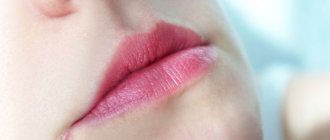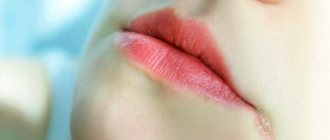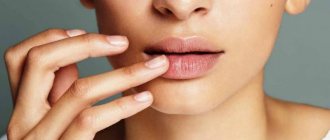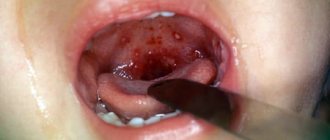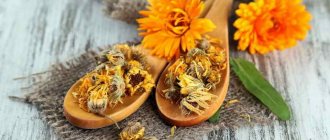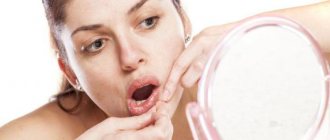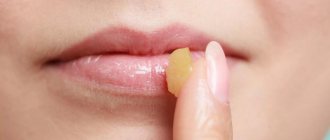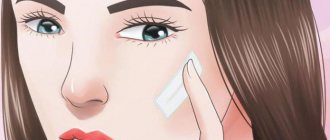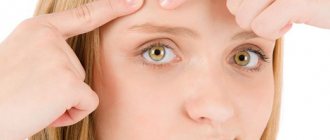Why might they appear?
Angulitis (angular stomatitis or cheilitis) appears due to excessive proliferation of streptococci, staphylococcus, and pathogenic fungal microflora. The main time of appearance is spring.
This is due to a decrease in immunity in most people due to a decrease in the amount of vitamins and microelements in the food they eat.
In more complex cases, it indicates a metabolic disorder, which may be associated with the body’s loss of the ability to absorb beneficial components of food.
This signals the need for a thorough medical examination to identify the primary disease.
Symptoms and diagnosis
- When a child has a seizure, before starting treatment, it is necessary to conduct a diagnosis and find out the cause. These defects appear in the form of small bubbles. But they quickly burst and cracks appear in their place, followed by yellowish crusts.
- Usually the disease is treated for no more than one to two weeks, but if it is caused by vitamin deficiency or decreased immunity, it persists for months. In this case, the skin around the lesion is red and swollen.
- If angulitis is caused by streptococcus, then itching and burning are added to the symptoms described above, especially after eating spicy, salty and sour foods; Pain occurs when speaking or opening the mouth. Dr. Komarovsky recommends first finding out the source. Otherwise, the treatment will be ineffective.
- A seizure caused by a fungus of the genus Candida does not crust over and is visible only when the lips are parted. Very often, this type of disease becomes chronic and makes itself felt when there is a lack of vitamins and a decrease in the body’s immune strength.
When seizures occur in children, Dr. Komarovsky recommends that you first consult a dermatologist to find out the cause of the disease. The doctor will order a laboratory test: a scraping is taken from the affected area and checked for fungi.
Before you put something on your child’s snacks, you need to take a general blood test to check the level of leukocytes, hemoglobin, sugar and ESR to rule out anemia, an inflammatory reaction, etc. Perhaps the doctor will prescribe a more accurate Wasserman test, which will allow you to determine streptococci, ruling out syphilis.
It is recommended to consult a hematologist, endocrinologist and therapist. If the wounds appear due to injury, then a visit to the dentist will be necessary.
Symptoms
In an uncomplicated situation, this dermatological problem occurs due to:
- using dishes that are poorly washed to remove dirt or after being sick;
- eating unwashed foods;
- stagnation of saliva in the corners of the mouth due to frequent licking of the lips;
- violations of oral hygiene;
- squeezing pimples in unsterile conditions;
- scratching the skin;
- severe hypothermia;
- dental malocclusion;
- mechanical damage to the skin (for example, during adaptation to dentures).
In difficult situations, doctors have to admit that angulitis is a sign of another, more complex disease.
Do you want to know where radio wave removal of oral leukoplakia is performed in Moscow? Then you should follow the link and read the article. If you are interested in the question of where to buy Corega cream for dentures, then we advise you to follow the link and read the article.
This symptom may be a consequence of the following health problems:
- anemia;
- diabetes;
- hypervitaminosis;
- pathological processes in the liver;
- vitamin deficiency (B2);
- prolonged high temperature;
- overdose of medications (antibiotics, cytostatics, hormones, etc.);
- immunodeficiency virus;
- metabolic disease;
- caries;
- allergic condition of the oral cavity;
- fungal infection of the oral mucosa.
What vitamin deficiencies do eating indicate a lack of?
One of the most common causes of microcracks in the corners of the lips is hypovitaminosis. This is a condition when the body lacks vitamins. Their insufficient content affects human health.
If seizures appear, what vitamin is missing? Most often this indicates a deficiency of B2 (riboflavin). At the same time, the condition of hair, nails, and skin may deteriorate. Without this vitamin, normal growth and regular cell renewal are impossible.
Riboflavin is involved in the transformation and activation of vitamin K, pyridoxine, and folic acid.
Other symptoms indicating vitamin B2 deficiency:
- your hair is falling out;
- damaged oral mucosa;
- the tongue is painful, colored red;
- irritation and peeling of the skin near the nose, mouth, and body;
- depression;
- increased sensitivity of the eyes to light, blurred vision and even cataracts;
- frequent dizziness.
The norm of riboflavin for all ages is 0.6 mg per thousand kcal.
How to quickly cure jams in the corners of the mouth?
Depending on the chosen treatment tactics, medications are usually prescribed, which are summarized in the table.
Examples of medications for angulitis:
| Oral use | External means |
| Nystatin | Stomatidin |
| Levorin | Tetracycline ointment |
| Fluconazole | Synthomycin liniment |
| Lamisil | Bepanthen/D-panthenol |
| Amoxil | Hyoxysone |
| Riboflavin/multivitamins | Triderm |
| Immunity boosters | Metrogyl denta |
The desired victory over seizures can be brought closer by changing the food products consumed and sanitizing the oral cavity.
In adults, this is possible by giving up smoking, alcohol, soda, marinades, sour, salty and spicy foods.
For a child, add vitamins to food and maintain oral hygiene. If necessary, sanitation.
For example, in small children under 2 years of age (due to the need for impact on the gums during teething), special attention is required to the cleanliness of pens and play toys. After all, they put all this in their mouth.
Therefore, it is impossible to prescribe external ointments to children. After all, their entry into the gastrointestinal tract is undesirable.
What products to supplement your diet with?
You can compensate for B2 deficiency by adding certain foods to your diet. Riboflavin is found in eggs, meat (including poultry), fish, dairy products, and liver.
Be sure to read:
How to get rid of dry and cracked heels
Vegetables include spinach, broccoli, and root greens.
Foods rich in vitamin B2. The picture shows how much it contains per 100 grams of product.
You should know that this vitamin is destroyed in light and at high temperatures. To avoid losing most of the riboflavin in food, do not store it in transparent containers and leave it out of reach of sunlight.
How to treat at home?
In mild cases, traditional methods of treating seizures are quite effective.
Here are the most popular options among the population:
- ear wax treatment;
- preparing a paste from plantain leaves and applying to damaged areas;
- splashing with thermal water;
- moisturizing the skin of the corners of the mouth with ointment made from pork/goose fat and honey (proportion 1:2);
- lotions based on rosehip, flax, tea or olive oils;
- antimicrobial method - applying a fresh cut of garlic to the jam;
- using bee propolis tincture, oak bark or alder cones;
- rinsing the corners of the mouth with a soda solution or a liquid mixture of ribloflavin and baking soda;
- rubbing the juice of Kalanchoe and buttercup leaves;
- lotions from infusion of herbs (sage, chamomile, tripartite, calendula, celandine);
- Regular change of towels, using them separately for hands and face.
Types of seizures and their difference from herpes
Seizures are divided into certain types depending on the initial cause of their appearance, which is easiest to determine at the second stage of development of the pathology - when the crusts have not yet appeared, but there is already a crack itself and discharge from it.
Visually, at the third stage of development, it is almost impossible to distinguish it from herpes. So how are these two diseases different?
- The appearance of herpes is caused by the presence of a herpes infection in the body. Jams can be the result of many infections, fungi, and even mechanical damage, which subsequently becomes infected from the outside.
- Herpes appears around the mouth on the lips, under the nose and on other parts of the body. Seizures appear exclusively in the corners of the mouth.
- Herpes looks like many small sores that develop into one large wound. The jam starts directly from the cracks.
- Herpes, if left untreated, can grow in any direction, making the person want to constantly scratch around the affected area. Seizures can spread further only as a result of constant mechanical damage to the skin, and this again occurs through cracks.
Since seizures and herpes are activated at moments of weakness of the human body, they are often combined into one affected area. It all starts with a banal seizure and continues with herpes. This happens very often. Therefore, it is better to visit a doctor and find out “what exactly” needs to be dealt with and with what drugs.
Consequences and complications
If left untreated, after the redness stage, cracks and blisters develop, which can spread to the surface of the lips. This is no longer just a visual problem. Itching and peeling begins.
While eating, when the mouth is opened wide, a painful rupture of the damaged area of skin occurs. Possible bleeding.
When drying occurs, the skin feels raw and tight. The disease becomes chronic and relapses occur easily.
Want to know how you can whiten your teeth at home without harm? Then you should follow the link and read the article. You can read what medications to take for sinusitis in adults at the following link.
And you can find out the answer to the question - how to relieve toothache at home during pregnancy, by following the link.
Symptoms
Despite a certain commonality in the clinical symptoms of cheilitis, each type is characterized by a certain specific clinic. Let's look at some types of cheilitis.
Exfoliative cheilitis . It is a chronic disease of the red border of the lips, accompanied by peeling of epithelial cells due to a violation of the process of their keratinization. Based on clinical symptoms, dry and exudative forms of the disease are distinguished.
The dry form is characterized by the presence at the border of the mucous membrane and the red border of a strip of thin transparent scales, similar to mica plates, which lag along the periphery and are tightly attached in the center. After 5-7 days, the scales are easily removed and the surface of the red border is exposed. As a rule, erosions do not form, but after a few days new ones form in place of the removed scales and this process can take a very long time without a tendency to self-heal. Often dry and exudative forms are considered as separate stages of one disease, which is due to the possibility of transforming these forms into one another.
The exudative form is characterized by the formation of massive gray-yellow or brown crusts on the edematous, hyperemic red border, mainly on the lower lip, which can reach significant sizes. The pathological process never spreads to the skin and mucous membrane. After removing the crusts, a bright red surface covered with exudate is formed; erosions do not form. The crusts periodically fall off and grow again. The figure below shows the dry and exudative form of the disease.
Actinic cheilitis . It is a chronic inflammation of the lips against the background of increased sensitivity and the presence of sensitization of the red border to ultraviolet radiation (sunlight). It appears mainly in the spring and summer, and can be combined with solar eczema of the face.
The lower lip is affected more often than the upper lip. There are two forms of actinic cheilitis - a dry form, in which the red border acquires a bright red color, becomes dry and covered with whitish-silver scales, and an exudative form, in which, against the background of a red edematous border, rapidly opening blisters appear, forming erosions, cracks and crusts ( Fig. below - dry and exudative forms).
Meteorological cheilitis . Inflammatory disease of the lips caused by meteorological factors (high or low humidity, wind, cold, dusty air, sunlight, etc.). Meteorological cheilitis occurs more often in men, as well as in diseases that are accompanied by increased dry skin ( ichthyosis , seborrhea , neurodermatitis , etc.).
Characterized by a chronic course. The red border of the lips is affected throughout its entire length. At the same time, the mucous membrane of the lip is not changed, there is no irritation on the skin of the lip (Fig. below). Malignancy is extremely rare. Glandular cheilitis . Caused by inflammation, hypertrophy and hyperfunction of small salivary glands moved to the red border. The lower lip is most often affected. Manifests after puberty, most often in people aged 40-60 years. There are serous and purulent inflammation of the salivary glands, and in case of prolonged course - fibrous inflammation, accompanied by keratinization around the excretory ducts. The clinical symptoms of serous inflammation are manifested by congestive hyperemia , swelling of the lips, and swelling of the lips is often present. The surface of the mucous membrane of the lip is lumpy, which is due to the protrusion of the hypertrophied salivary glands above the surface. At the same time, a clear, light liquid is released from the dilated ducts of the glands (symptom of dew). Since the lip is periodically wetted with quickly evaporating saliva, dryness of the lips (red border) develops, the mucous membrane peels off and erosions/cracks appear on it.
A purulent form of inflammation on the lip develops due to infection of the excretory ducts of the salivary glands by pathogenic microflora. More often there is diffuse damage to the salivary glands and much less often - limited purulent inflammation of several glands. The lip is characterized by enlargement, pain and swelling, the red border is covered with tightly fitting green-yellow crusts. Erosion and cracks appear near the excretory ducts. When pressing on the excretory ducts, a cloudy, thick proteinaceous secretion containing purulent exudate flows out. abscesses can form .
With a long course, the disease may transform into a fibrous form, as a result of which fibrosis of the connective tissue develops, which contributes to the closure of the excretory ducts, the accumulation of secretions in them, which, without finding a way out, forms cysts. There is a significant increase in lip size; there is inflammation of the lip on the inside, the surface of the red border is lumpy and congestively hyperemic. Due to the process of keratinization, a visually detectable rim of epithelial opacification is formed around the excretory ducts.
Lymphoedematous macrocheilitis . The disease is caused by impaired lymph circulation caused by sensitization of the body by microflora localized in foci of chronic infection. The course is chronic with periodic exacerbations. Clinically it manifests as painless enlargement and deformation of the lips, which progresses after each exacerbation. During pathohistological examination, pronounced edema , cystic dilatation of lymph vessels , and in the late stage, deep degenerative changes in all tissues of the lip are observed (Fig. below). The color of the red border of the lips and skin is stagnant-cyanotic (blue lips) or pale.
Atopic cheilitis . It is one of the manifestations of neurodermatitis/dermatitis. Atopic cheilitis is characterized by damage to the skin and red border of the lips, while the pathological process is most pronounced in the area of the corners of the mouth, which is manifested by the formation of jams in the corners of the lips. The mucous membrane of the lips is never involved in the process. The disease manifests itself with itching, the appearance of swelling of the red border of the lips and erythema with the simultaneous development of an inflammatory process in areas of the facial skin adjacent to the lips and characteristic lesions of the corners of the lips with dryness, infiltration and cracking. As the acute inflammatory phenomena subside, peeling/lichenification of the lips begins, which is combined with peeling/dryness of the facial skin (Fig. below).
Eczematous cheilitis . It is an allergic disease of the skin/red border of the lips with an acute/chronic course. Eczematous cheilitis can occur either as an isolated lesion or as one of the manifestations of facial eczema. A variety of substances (medicines, microorganisms, nutrients, toothpaste components, metals, etc.) can act as allergens. The acute course is characterized by a sequential polymorphism of the elements of the lesion: redness, then small vesicles filled with serous exudate, which, bursting and merging with each other, form ring-shaped scales, and then crusts. All elements of the rash are accompanied by swelling and itching of the lips.
The pathological process spreads to the corners of the mouth and the skin adjacent to the red border. Chronization of the process helps reduce swelling , hyperemia and oozing. There is yellowish-red hyperemia/chronic swelling of the lips, dry peeling; Bloody crusts and cracks appear in places. The disease occurs with periodic exacerbations (Fig. below).
Angular cheilitis . The process is predominantly two-way. Maceration of skin folds in the corners of the lips is characteristic. Patients complain of pain when eating/talking and opening the mouth. As a rule, the mucous membrane in the commissure area, as well as the skin in adjacent areas, are involved in the inflammatory process. Infiltration of the epithelium of the lips and adjacent skin is characteristic. Angular cheilitis can also manifest as painful erosions in the corners of the lips. A secondary fungal/staphylococcal infection may be associated (Fig. below).
Candidal cheilitis . Inflammation of the red border of the lips caused by the fungus Candida . It can be either an independent disease or a manifestation of oropharyngeal candidiasis . It has a chronic course with periodic alternating exacerbations and remissions or is persistent in nature. The candidiasis process affects the red border of the lips, mainly the lower one. At the beginning it manifests itself as peeling of the lips, which are covered with easily removable whitish films. As the disease progresses, in place of the films, plates tightly fused to the tissue with raised edges form, under which eroded areas are visible. Cracks and crusts appear on the surface of the lip. Patients are bothered by a burning sensation when eating irritating foods, dry lips, pain at the cracks when opening the mouth (Fig. below).
Treatment for seizure in a child
Children quite often develop jams in the corners of their mouths, which is due to the baby’s desire to taste everything.
As a rule, the child does not really like the methods of treating the disease. They are not as tolerant as adults to garlic juice, for example, or to lotions of herbs or oils. Treating jams in the corners of a child’s mouth should begin with a set of hygiene procedures , because the problem may be associated with exposure to microorganisms. Care must be taken to ensure that children do not put dirty objects or toys in their mouths, or eat sand, clay or chalk. If this happens, you should rinse the child’s mouth, wipe the skin of the lips and face well, and lubricate it with some pleasant cream.
If a child has a sticky mouth, it is recommended to consult a pediatrician. Based on the reason, he will prescribe a medicine that will be most effective in a particular case. In most cases, ointments prepared at home are prescribed. This can be a product based on petroleum jelly, goose fat, melted beeswax, or vegetable oil. You can expect a good effect from cucumber juice or honey if you lubricate it on your lips at night. You can get rid of the jam much faster if you can persuade the child to allow you to treat his lips with lotions made from essential oils or herbs.
Additional measures and prevention
In addition to therapy that eliminates the cause, auxiliary therapy is required to prevent relapses. Vitamin ointments Panthenol and Bepanten, providing the skin with additional pantothenic acid. Vitaon (one of Karavaev’s balms) is a complex complex based on plant substances (essential oils, calendula, fennel, rose hips, pine, chamomile, mint, St. John’s wort, etc.). Vitaon accelerates regeneration processes, inhibits the development of inflammation and has a slight antiseptic effect. Zinc paste creates good protection against excessive evaporation of moisture from the epidermis and protects against re-entry of microorganisms. And of course, you need proper, fortified nutrition. Skin health is primarily affected by a lack of vitamin B2 in food.
Folk remedies against jam
In some cases, sticking in the corners of the mouth can be quickly and reliably gotten rid of using traditional medicine recipes.
A herbal lotion, prepared from chamomile, celandine, calendula, and sage, helps well. A lotion made from green tea, oak bark, and alder cones is also effective. Oils (tea tree, rosehip, avocado) can be used to remove jams by moistening a cotton swab and applying to the affected area of skin for 5-10 minutes. For angular angulitis, propolis is effective because it has anti-inflammatory and bactericidal effects. To prepare a tincture from it, you need to take 10 grams of propolis and 100 grams of butter, heat them in one container and treat the wound with the product several times a day.
Not only an effective, but also a tasty way to get rid of sticky spots in the corners of your mouth is an apple mask , which is prepared with the addition of butter. A carrot-curd mask will help improve the condition of your lips. Sometimes angulitis is treated with earwax. This is probably the most accessible remedy. Use a cotton swab to remove some wax from your ear and wipe the damaged skin with it. The procedure is repeated several times a day.
There are many other traditional medicine recipes that are based on the use of medicinal plants and are effective in eliminating seizures. The leaves of plantain, string, buttercup, celandine, and Kalanchoe have healing abilities. You should be careful with celandine juice, as using it in its pure form can cause burns to the surface of the skin. Kalanchoe juice is used in the treatment of not only angulitis, but also other diseases of the oral cavity (stomatitis, gingivitis). This is an excellent disinfectant and has an anti-inflammatory and wound-healing effect.
Recommendations for patients
To treat the disease, it is necessary to first eliminate external irritants that have a negative effect on the skin.
Patients suffering from angulitis need to:
- Quit smoking.
- Review your diet by removing sour and spicy foods from the menu. It is necessary to include foods containing iron and B vitamins in your food, such as liver, apples, pomegranates, dairy products, peanuts, cabbage, and almonds.
- Avoid licking your lips frequently.
- To soften the skin around the mouth during seizures, it is necessary to use cosmetics with a medicinal bias - hygienic lipstick or lip balm with components and vitamins that soften your skin.
Prevention of seizures in adults and children
Prevention of the formation of wounds in the corners of the mouth consists of providing proper care and eliminating exposure to risk factors. Preventive measures include:
- To care for the skin of the lips, the use of hygienic lipstick. You can use honey, cream, baby cream, Vaseline, olive oil. In summer, you should protect your lips from exposure to ultraviolet radiation.
- Seizures can appear as a result of problems in the field of dentistry; teeth need to be treated in a timely manner, cleaned of stone, removed and changed braces or dentures.
- Immunity plays an important role, you need to monitor your health, eat right, take vitamins, and exercise.
- Parents need to ensure that young children do not put unwashed hands or toys into their mouths. A child with the appearance of his first teeth must be taught how to care for the oral cavity.
Paying attention to your health and the health of your children will reduce the risk of cracks on the lips and corners of the mouth. If jams appear, then treatment should be consistent and consist of eliminating the root cause of the formation of the wound. There is no need to stop therapy when you feel the first signs of improvement. If sores occur frequently, you should visit a doctor and undergo an examination.
The article has been verified by the editors
Possible complications
Sores in the corners of the mouth are an unpleasant defect, but do not threaten serious complications if treated. You need to pay attention to therapy during pregnancy; many medications are not suitable for pregnant women and can cause an allergic reaction.
If the sore is not smeared with medicinal ointments, then there is a risk of turning into a deep crack in the corner of the mouth, which is more difficult to cure.
The main complication of wounds is the penetration of fungal and bacterial infections. Inflammation affects neighboring tissues, reaches the lymphatic vessels, provoking the release of purulent contents from the crack. The skin around the jam becomes denser and rougher. If the inflammatory process is not stopped, it will invade new areas of the skin, forming new wounds that will merge.
